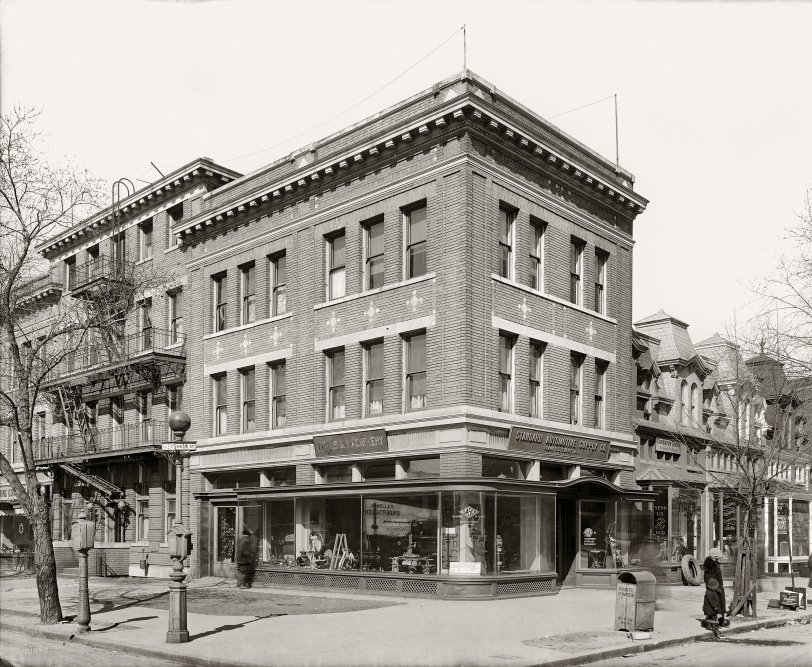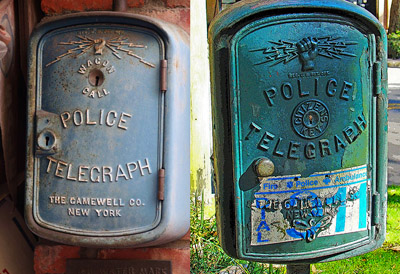


Framed or unframed, desk size to sofa size, printed by us in Arizona and Alabama since 2007. Explore now.
Shorpy is funded by you. Patreon contributors get an ad-free experience.
Learn more.

- Lofty addition
- In 1912
- Keenan Building
- Six years old
- Taken from the P.J. McArdle Roadway?
- It stood only 47 years
- Three track mind
- Incline to the right
- Reach for the sky, 1912 style
- No clean sweep
- Same Job Title, Same Face
- Sadly Lost
- Beautiful ...
- Where you get your kicks
- Aim High
- Pueblo Revival sisters
- Pueblo Neoclassicism
- Milk Man
- Regional dialect.
- Spielberg's inspiration
- Great Photo
- Loaf Story
- Do you still have the Rakes category?
- Could almost be a scene from the 1957 movie 'Hell Drivers'
- The Wages of Fear.
- Conspicuous by their absence
- Got Milk?
- All that aluminum
- No lefties
- Smoke 'em if you've got 'em
Print Emporium
Standard Automotive: 1926

Washington, D.C., circa 1926. "Standard Automotive Supply Co., 14th & S streets N.W." We've seen the interior here. National Photo Co. View full size.
Cast iron architectural
Quite a lot of cast iron skirting and grates have been used in the display window support in these buildings. I wonder if they are original to the building or were added later? Cast iron ornament and even entire building facades came into popularity before the Civil War and were manufactured into the 20th century; it was cheaper and more durable than the stonework it sometimes imitated, and of course, it allowed for intricate scroll and openwork that would have been nearly impossible in masonry or wood. A great deal survives into the 21st century where the buildings have not been razed.
P.A.. Lomax
The reflection in the window indicates that P.A. Lomax was the undertaker across the street.
Frank G. Stewart
Stewart, Auto Supply Head, Dies
Frank Gregory Stewart, who was in the automotive industry here for more than a half century, died of a heart attack yesterday at his home, 1701 Holly st. nw. He was president of Standard Automotive Supply Co. and Stewart Manufacturing Co. and a member of numerous professional groups.
Mr. Stewart was born 65 years ago in Ohiopyle, Pa. He studied engineering at Maryland University and Stevens Institute of Technology, in Hoboken, N.J. He came to Washington before World War I and was granted the Reo automobile agency for the district.
Mr. Stewart organized the Standard Automotive Supply Co., 1835 14th st. nw., shortly after World War I. The firm was incorporated in the late 1920s and Mr. Stewart served as president until his death. The Stewart Manufacturing Co., an affiliate of Standard Automotive, was founded shortly after World War II. Products manufactured by the company include several of Mr. Stewart's inventions, including a screw and nut locator and an automotive stethoscope for testing engines.
Mr. Stewart was the founder and first president of the local chapter of the Automobile Oldtimers, a national organization. He recently was made an honorary member of the Antique Automobile Club of America. He also belonged to the Automotive Engineers, Society of American Military Engineers, Washington Board of Trade, Washington Automotive Trade Association, Navy League, and George Washington Post of the American Legion. In 1954 Mr. Stewart was chairman of the million dollar automotive industries show in Chicago.
He is survived by his wife, Phyllis O'Hara Stewart. A service well be held at 10 a.m. Friday at Hines funeral home, 2901 14th st. nw. A Navy veteran of World War I, Stewart will be buried in Arlington Cemetery.
Washington Post, Sep 11, 1957
Boston telegraph alarms
I was amazed to find that Boston (among others) still maintains a fire alarm telegraph call box system.
1800 14th Street NW
The building is still there, amazingly preserved. Although its neighbors on 14th are gone. It's right across the street from Crosstown Auto Supply, whose building is also still with us.
Call boxes
Ok, Sorry if this has been explained to death, but I need clarification. The box on the right looks like a policeman's phone box, and if that's true, what's the other box for? A fire alarm?
Also The hanging weight for the fire escape in between the two boxes just brought back a bunch of memories. We had one old escape like that, and we used to swing on them as a kid. That's probably why you don't see them set up like that anymore.
[The box on the left is marked "Police Telegraph." Similar boxes made by Gamewell are shown below. The box with the light looks like a fire call box. Washington also had similar police call boxes. According to a 1925 article in the Washington Post, the first fire alarm telegraphs in the District were installed in 1864, then replaced in 1875 by a Gamewell system that was updated in 1909. By 1925 the number of Gamewell boxes was 825. "Every fire-alarm box located on the street is equipped with a red light that burns continuously, making it conspicuous in emergencies for the man on the street."
The article goes on to note that the police call boxes in Precincts 12 and 1 through 8 were maintained by the telephone company, while call boxes in other precincts "are the old Gamewell type." Details on operation of the police telegraph boxes can be found here. - Dave]

























On Shorpy:
Today’s Top 5